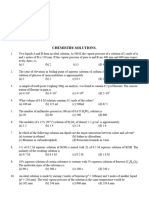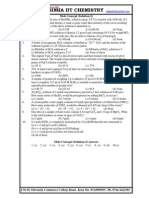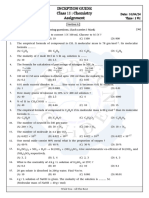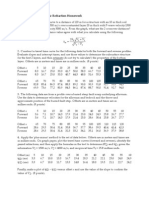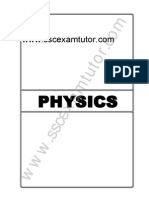LIDUID SOLUTION ASSIGNMENT - 01
Uploaded by
Gulab WaghLIDUID SOLUTION ASSIGNMENT - 01
Uploaded by
Gulab WaghASSIGNMENT – 01 LIQUID SOLUTIONS DURATION: 4 HOURS
1. 25 ml of 3.0 M HNO 3 are mixed with 75 ml of 4.0 M HNO3 . If 14. The molarity of a solution made by mixing 50ml of conc. H 2 SO 4
the volumes are additive, the molarity of the final mixture would be (36N) with 50 ml of water is
(a) 36 M (b) 18 M
(a) 3.25 M (b) 4.0 M (c) 9 M (d) 6 M
(c) 3.75 M (d) 3.50 M 15. The volumes of 4 N HCl and 10 N HCl required to make 1 litre
of 6 N HCl are
2. The molarity of 0.006 mole of NaCl in 100ml solution is
(a) 0.6 (b) 0.06 (a) 0.75 litre of 10 N HCl and 0.25 litre of 4 N HCl
(c) 0.006 (d) 0.066 (b) 0.25 litre of 4 N HCl and 0.75 litre of 10 N HCl
(e) None of these (c) 0.67 litre of 4 N HCl and 0.33 litre of 10 N HCl
3. What will be the molarity of a solution containing 5 g of sodium (d) 0.80 litre of 4 N HCl and 0.20 litre of 10 N HCl
hydroxide in 250 ml solution (e) 0.50 litre of 4 N HCl and 0.50 litre of 10 N HCl
(a) 0.5 (b) 1.0 16. Which statement is true for solution of 0.020 M H 2 SO 4
(c) 2.0 (d) 0.1 (a) 2 litre of the solution contains 0.020 mole of SO 42
4. Which of the following has maximum number of molecules
(a) 16 gm of O 2 (b) 16 gm of NO 2 (b) 2 litre of the solution contains 0.080 mole of H 3 O
(c) 7 gm of N 2 (d) 2 gm of H 2 (c) 1 litre of the solution contains 0.020 mole H 3 O
5. Molarity is expressed as (d) None of these
(a) Gram/litre (b) Moles/litre 17. 10 litre solution of urea contains 240g urea. The active mass of urea
(c) Litre/mole (d) Moles/1000 gms will be
(a) 0.04 (b) 0.02
6. 20 ml of HCl solution requires 19.85 ml of 0.01 M NaOH
(c) 0.4 (d) 0.2
solution for complete neutralization. The molarity of HCl solution
is 18. The amount of K 2 Cr2 O7 (eq. wt. 49.04) required to prepare 100 ml
(a) 0.0099 (b) 0.099 of its 0.05 N solution is
(c) 0.99 (d) 9.9 (a) 2.9424 g (b) 0.4904 g
7. 3
How much of NaOH is required to neutralise 1500 cm of 0.1 N (c) 1.4712 g (d) 0.2452 g
HCl (At. wt. of Na =23) 19. The number of moles present in 2 litre of 0.5 M NaOH is
(a) 4 g (b) 6 g (a) 0.5 (b) 0.1
(c) 40 g (d) 60 g (c) 1 (d) 2
8. The number of molecules in 4.25 g of ammonia is approximately 20. 36g water and 828g ethyl alcohol form an ideal solution. The mole
(a) 0.5 10 23 (b) 1.5 10 23 fraction of water in it, is
(a) 1.0 (b) 0.7
(c) 3.5 10 23 (d) 2.5 10 23
(c) 0.4 (d) 0.1
9. The largest number of molecules is in
21. What will be the normality of a solution containing 4.9 g. H 3 PO4
(a) 25 g of CO 2 (b) 46 g of C 2 H 5 OH
dissolved in 500 ml water
(c) 36 g of H 2 O (d) 54 g of N 2 O 5 (a) 0.3 (b) 1.0
10. If 1 M and 2.5 litre NaOH solution is mixed with another 0.5 M and (c) 3.0 (d) 0.1
3 litre NaOH solution, then molarity of the resultant solution will be 22. 3.0 molal NaOH solution has a density of 1.110 g/ml. The molarity
(a) 1.0 M (b) 0.73 M of the solution is
(c) 0.80 M (d) 0.50 M (a) 3.0504 (b) 3.64
11. When a solute is present in trace quantities the following expression (c) 3.05 (d) 2.9732
is used 23. The number of molecules in 16 gm of methane is
(a) Gram per million (b) Milligram percent
(a) 3.0 10 23 (b) 6.02 10 23
(c) Microgram percent (d) Nano gram percent
16 16
(e) Parts per million (c) 10 23 (d) 10 23
6 .02 3 .0
12. When the concentration is expressed as the number of moles of a
solute per litre of solution it known as 24. The normality of a solution of sodium hydroxide 100 ml of which
(a) Normality (b) Molarity contains 4 grams of NaOH is
(c) Mole fraction (d) Mass percentage (a) 0.1 (b) 40
(e) Molality (c) 1.0 (d) 0.4
13. The normality of 2.3 M H 2 SO 4 solution is 25. Molar solution means 1 mole of solute present in
(a) 1000g of solvent (b) 1 litre of solvent
(a) 2.3 N (b) 4.6 N
(c) 1 litre of solution (d) 1000g of solution
(c) 0.46 N (d) 0.23 N
201,MATHOSHREE PLAZA, VENUS CORNER, KOLHAPUR.416001. CONTACT NO 8976981312
26. What will be the molality of a solution having 18 g of glucose (mol. 36. The volume strength of 1.5 N H 2 O 2 solution is
wt. = 180) dissolved in 500 g of water (a) 4.8 (b) 5.2
(a) 1 m (b) 0.5 m (c) 8.8 (d) 8.4
(c) 0.2 m (d) 2 m 37. How many gm of H 2 SO 4 is present in 0.25 gm mole of H 2 SO 4
27. A solution of Al2 (SO 4 )3 {d 1.253 gm / ml} contain 22% salt by (a) 24.5 (b) 2.45
weight. The molarity, normality and molality of the solution is (c) 0.25 (d) 0.245
(a) 0.805 M, 4.83 N, 0.825 M 38. 20 g of hydrogen is present in 5 litre vessel. The molar concentration
(b) 0.825 M, 48.3 N, 0.805 M of hydrogen is
(a) 4 (b) 1
(c) 4.83 M, 4.83 N, 4.83 M
(c) 3 (d) 2
(d) None
39. To prepare a solution of concentration of 0.03 g/ml of AgNO3 ,
28. Which of the following should be done in order to prepare
0.40 M NaCl starting with 100 ml of 0.30 M NaCl (mol.wt. of what amount of AgNO3 should be added in 60 ml of solution
(a) 1.8 (b) 0.8
NaCl 58.5 )
(c) 0.18 (d) None of these
(a) Add 0.585 g NaCl (b) Add 20 ml water
40. The molarity of a solution of Na 2 CO 3 having 10.6 g / 500ml of
(c) Add 0.010ml NaCl (d) Evaporate 10ml water solution is
29. Which of the following solutions has the highest normality (a) 0.2 M (b) 2 M
(a) 8 gm of KOH / litre (b) N phosphoric acid (c) 20 M (d) 0.02 M
(c) 6 gm of NaOH / 100 ml (d) 0.5 M H 2 SO 4 41. On passing H 2 S gas through a solution of Cu and Zn 2 ions,
30. Hydrochloric acid solution A and B have concentration of 0.5 N CuS is precipitated first because
and 0.1 N respectively. The volumes of solutions A and B (a) Solubility product of CuS is equal to the ionic product of ZnS
required to make 2 litres of 0.2 N HCl are (b) Solubility product of CuS is equal to the solubility product of
(a) 0 .5 l of A 1.5 l of B ZnS
(b) 1 .5 l of A 0.5l of B (c) Solubility product of CuS is lower than the solubility product
of ZnS
(c) 1 .0 l of A 1.0 l of B
(d) Solubility product of CuS is greater than the solubility product
(d) 0.75 l of A 1.25l of B of ZnS
31. Conc. H 2 SO 4 has a density of 1.98 gm/ml and is 98% H 2 SO 4 by 42. The number of moles of solute per kg of a solvent is called its
weight. Its normality is (a) Molarity (b) Normality
(a) 2 N (b) 19.8 N (c) Molar fraction (d) Molality
(c) 39.6 N (d) 98 N 43. Molecular weight of glucose is 180. A solution of glucose which
N contains 18 gms per litre is
32. With 63 gm of oxalic acid how many litres of solution can be (a) 2 molal (b) 1 molal
10
prepared (c) 0.1 molal (d) 18 molal
(a) 100 litre (b) 10 litre 44. 0.5 M of H 2 SO 4 is diluted from 1 litre to 10 litre, normality of
(c) 1 litre (d) 1000 litre resulting solution is
33. Molarity of 0.2 N H 2 SO 4 is (a) 1 N (b) 0.1 N
(a) 0.2 (b) 0.4 (c) 10 N (d) 11 N
(c) 0.6 (d) 0.1 45. If one mole of a substance is present in 1 kg of solvent, then
34. When WB gm solute (molecular mass M B ) dissolves in WA gm (a) It shows molar concentration
solvent. The molality M of the solution is (b) It shows molal concentration
WB MB WB 1000 (c) It shows normality
(a) (b)
W A 1000 MB WA (d) It shows strength gm / gm
W A 1000 WA M B 46. 10 grams of a solute is dissolved in 90 grams of a solvent. Its mass
(c) (d) percent in solution is
WB MB WB 1000
(a) 0.01 (b) 11.1
35. Normality (N ) of a solution is equal to (c) 10 (d) 9
No. of moles of solute 47. Calculate the molality of 1 litre solution of 93% H 2 SO 4
(a)
Volume of solutionin litre
(weight/volume). The density of the solution is 1.84 g /ml
No. of gram equivalent of solute (a) 10.43 (b) 20.36
(b)
Volume of solutionin litre (c) 12.05 (d) 14.05
No. of moles of solute 48. Volume of water needed to mix with 10 ml 10N HNO 3 to get 0.1 N
(c)
Mass of solvent in kg HNO 3
(d) None of these (a) 1000 ml (b) 990 ml
(c) 1010 ml (d) 10 ml
201,MATHOSHREE PLAZA, VENUS CORNER, KOLHAPUR.416001. CONTACT NO 8976981312
49. The sum of the mole fraction of the components of a solution is 61. The normality of 10% (weight/volume) acetic acid is
(a) 0 (b) 1 (a) 1 N (b) 10 N
(c) 2 (d) 4 (c) 1.7 N (d) 0.83 N
50. Increasing the temperature of an aqueous solution will cause 62. Unit of mole fraction is
(a) Decrease in molality (a) Moles/litre (b) Moles/litre2
(b) Decrease in molarity (c) Moles–litre (d) Dimensionless
(c) Decrease in mole fraction 63. Molar concentration (M ) of any solution =
(d) Decrease in % w/w No. of moles of solute
(a)
51. 1000 gms aqueous solution of CaCO 3 contains 10 gms of Volume of solutionin litre
carbonate. Concentration of the solution is No. of gram equivalent of solute
(b)
(a) 10 ppm (b) 100 ppm Volume of solutionin litre
(c) 1000 ppm (d) 10000 ppm No. of moles of solute
(c)
52. 3.65 gms of HCl is dissolved in 16.2 gms of water. The mole fraction Mass of solvent in kg
of HCl in the resulting solution is
No. of moles of any constituent
(a) 0.4 (b) 0.3 (d)
Total no. of moles of all constituents
(c) 0.2 (d) 0.1
64. 1 Molar solution contains
53. An aqueous solution of glucose is 10% in strength. The volume in
(a) 1000g of solute (b) 1000g of solvent
which 1 gm mole of it is dissolved will be
(c) 1 litre of solvent (d) 1 litre of solution
(a) 18 litre (b) 9 litre
65. To neutralise completely 20 mL of 0.1 M aqueous solution of
(c) 0.9 litre (d) 1.8 litre
phosphorous acid (H 3 PO3 ), the volume of 0.1 M aqueous KOH
20
54. 6.02 10 molecules of urea are present in 100 ml of its solution. solution required is
The concentration of urea solution is (a) 40 mL (b) 20 mL
(a) 0.02 M (b) 0.01 M
(c) 10 mL (d) 60 mL
(c) 0.001 M (d) 0.1 M 66. On dissolving 1 mole of each of the following acids in 1 litre water,
(Avogadro constant, N A 6.02 10 23 mol 1 ) the acid which does not give a solution of strength 1 N is
55. The number of moles of SO 2 Cl 2 in 13.5 gm is (a) HCl (b) Perchloric acid
(a) 0.1 (b) 0.2
(c) HNO 3 (d) Phosphoric acid
(c) 0.3 (d) 0.4
67. 10ml of conc. H 2 SO 4 (18 molar) is diluted to 1 litre. The
56. The weight of H 2C2O4 . 2 H 2O required to prepare 500ml of
approximate strength of dilute acid could be
0.2 N solution is (a) 0.18 N (b) 0.09 N
(a) 126 g (b) 12.6 g
(c) 0.36 N (d) 1800 N
(c) 63 g (d) 6 .3 g 68. The normality of 10 lit. volume hydrogen peroxide is
1 (a) 0.176 (b) 3.52
57. 10 N and N solution is called (c) 1.78 (d) 0.88
10
(a) Decinormal and decanormal solution (e) 17.8
69. Essential quantity of ammonium sulphate taken for preparation of 1
(b) Normal and decinormal solution
molar solution in 2 litres is
(c) Normal and decanormal solution
(a) 132 gm (b) 264 gm
(d) Decanormal and decinormal solution
(c) 198 gm (d) 212 gm
58. When 7.1gm Na 2 SO 4 (molecular mass 142) dissolves in
100 ml H 2 O , the molarity of the solution is 70. In a mixture of 1 gm H 2 and 8 gm O 2 , the mole fraction of
(a) 2.0 M (b) 1.0 M hydrogen is
(a) 0.667 (b) 0.5
(c) 0.5 M (d) 0.05 M
(c) 0.33 (d) None of these
59. Molarity of 4% NaOH solution is
(a) 0.1M (b) 0.5 M 71. If 0.50 mol of CaCl 2 is mixed with 0.20 mol of Na 3 PO4 , the
(c) 0.01M (d) 1.0 M maximum number of moles of Ca 3 (PO4 )2 which can be formed, is
(a) 0.70 (b) 0.50
60. When 6 gm urea dissolve in 180 gm H 2 O . The mole fraction of
(c) 0.20 (d) 0.10
urea is
10 10 . 1
(a) (b)
10 . 1 10 72. An X molal solution of a compound in benzene has mole fraction
of solute equal to 0.2. The value of X is
10 . 1 0 .1
(c) (d) (a) 14 (b) 3.2
0 .1 10 . 1
(c) 4 (d) 2
201,MATHOSHREE PLAZA, VENUS CORNER, KOLHAPUR.416001. CONTACT NO 8976981312
73. Molecular weight of urea is 60. A solution of urea containing 6 g 83. The amount of NaOH in gms in 250 cm 3 of a 0.100 M NaOH
urea in one litre is solution would be
(a) 1 molar (b) 1.5 molar (a) 4 gm (b) 2 gm
(c) 0.1 molar (d) 0.01 molar (c) 1 gm (d) 2.5 gm
74. The weight of sodium carbonate required to prepare 500 ml of a 84. 4.0 gm of NaOH are contained in one decilitre of solution. Its
semi- normal solution is molarity would be
(a) 13.25 g (b) 26.5 g
(a) 4 M (b) 2 M
(c) 53 g (d) 6.125 g
(c) 1 M (d) 1.5 M
75. 200ml of a solution contains 5.85 g dissolved sodium chloride.
85. When 90 gm of water is mixed with 300 gm of acetic acid. The total
The concentration of the solution will be (Na 23; Cl 35.5)
number of moles will be
(a) 1 molar (b) 2 molar (a) 5 (b) 10
(c) 0.5 molar (d) 0.25 molar
(c) 15 (d) 20
76. Molarity of a solution prepared by dissolving 75.5 g of pure KOH in
540 ml solution is 86. A molal solution is one that contains one mole of a solute in
(a) 3.05 M (b) 1.35 M (a) 1000 gm of the solvent
(c) 2.50 M (d) 4.50 M (b) One litre of the solvent
(c) One litre of the solution
77. Addition of conc. HCl to saturated BaCl2 solution precipitates (d) 22.4 litres of the solution
BaCl2 ; because
(a) It follows from Le Chatelier’s principle 87. What weight of ferrous ammonium sulphate is needed to prepare 100
(b) Of common-ion effect ml of 0.1 normal solution (mol. wt. 392)
(a) 39.2 gm (b) 3.92 gm
(c) Ionic product (Ba ), (Cl ) remains constant in a saturated
(c) 1.96 gm (d) 19.6 gm
solution
(d) At constant temperature, the product (Ba 2 ), (Cl )2 remains
88. If 18 gm of glucose (C6 H 12 O6 ) is present in 1000 gm of an aqueous
constant in a saturated solution
solution of glucose, it is said to be
(a) 1 molal (b) 1.1 molal
78. How much water is needed to dilute 10 ml of 10 N hydrochloric acid
(c) 0.5 molal (d) 0.1 molal
to make it exactly decinormal (0.1 N)
(a) 990 ml (b) 1000 ml
(c) 1010 ml (d) 100 ml 89. The number of moles of KCl in 1000 ml of 3 molar solution is
79. The formula weight of H 2 SO 4 is 98. The weight of the acid in (a) 1 (b) 2
400ml of 0.1M solution is (c) 3 (d) 1.5
(a) 2.45 g (b) 3.92 g
(c) 4.90 g (d) 9 .8 g 90. The unit of molality is
(a) Mole per litre (b) Mole per kilogram
(c) Per mole per litre (d) Mole litre
80. The molarity of pure water is
(a) 55.6 (b) 5.56
(c) 100 (d) 18
81. The molarity of a 0.2 N Na 2 CO 3 solution will be
(a) 0.05 M (b) 0.2 M
(c) 0.1 M (d) 0.4 M
82. If we take 44 g of CO 2 and 14 g of N 2 what will be mole
fraction of CO 2 in the mixture
(a) 1/5 (b) 1/3
(c) 2/3 (d) 1/4
201,MATHOSHREE PLAZA, VENUS CORNER, KOLHAPUR.416001. CONTACT NO 8976981312
You might also like
- Section 5.3 Representative Groups: Reading Strategy67% (3)Section 5.3 Representative Groups: Reading Strategy2 pages
- Class - 12 Vedantu Chemistry Chp-1 Objective Questions With SolutionsNo ratings yetClass - 12 Vedantu Chemistry Chp-1 Objective Questions With Solutions21 pages
- 4.Solutions and Colligative Properties -Part ANo ratings yet4.Solutions and Colligative Properties -Part A17 pages
- Concentration Terms Practice Questions 1728747202No ratings yetConcentration Terms Practice Questions 17287472023 pages
- 12TH CHEMISTRY (DPQ-01SOLUTIONS NCERT)15.05.24_82659c6f-89b9-4c94-9703-54140d9dc4e8No ratings yet12TH CHEMISTRY (DPQ-01SOLUTIONS NCERT)15.05.24_82659c6f-89b9-4c94-9703-54140d9dc4e812 pages
- Mole Concept Solution Practice Set Objective by S.K.sinha See Chemistry Animations at50% (2)Mole Concept Solution Practice Set Objective by S.K.sinha See Chemistry Animations at1 page
- Tutorial Sheet - 1 - Xii - Liquid Solutions (Concentration Terms and Henry-S Law) - 27416162No ratings yetTutorial Sheet - 1 - Xii - Liquid Solutions (Concentration Terms and Henry-S Law) - 274161629 pages
- JR MPC Chemistry-Dpp - 2 JR MPC Chemistry - DPP - 2 JR MPC Chemistry - DPP - 2No ratings yetJR MPC Chemistry-Dpp - 2 JR MPC Chemistry - DPP - 2 JR MPC Chemistry - DPP - 24 pages
- Std-12 Ncert Chem Chap 1 [1.1 & 1.2] Test AnswersNo ratings yetStd-12 Ncert Chem Chap 1 [1.1 & 1.2] Test Answers6 pages
- Xi-Ch-1-Assignment Sheet-2-Concentration UnitsNo ratings yetXi-Ch-1-Assignment Sheet-2-Concentration Units2 pages
- Race # 01 - Chemistry - Liquid Solution - SCNo ratings yetRace # 01 - Chemistry - Liquid Solution - SC1 page
- Some Basic Concept of Chemistry - DPP-11No ratings yetSome Basic Concept of Chemistry - DPP-113 pages
- Mole Concept Solution Practice Set ObjectiveNo ratings yetMole Concept Solution Practice Set Objective3 pages
- 1001-Class XI - C-232.Mole Concept Assignment - 1No ratings yet1001-Class XI - C-232.Mole Concept Assignment - 15 pages
- DPP-5_b4ad2c53-e783-4955-81cd-3fffbdbedfc9No ratings yetDPP-5_b4ad2c53-e783-4955-81cd-3fffbdbedfc92 pages
- Concentration Terms and Eudiometry: (Physical Chemistry) Exercise (O-I) Introduction of Concentration Terms 1100% (1)Concentration Terms and Eudiometry: (Physical Chemistry) Exercise (O-I) Introduction of Concentration Terms 159 pages
- IIT JEE Previous Year DISHA Question BankNo ratings yetIIT JEE Previous Year DISHA Question Bank148 pages
- NEET National Eligibility Cum Entrance Test Chemistry Class 11 + 12 Volume I + Volume IIFrom EverandNEET National Eligibility Cum Entrance Test Chemistry Class 11 + 12 Volume I + Volume IINo ratings yet
- Ozone Equipment Manufacturer and Ozone System Integrators Test Ozone Output From Industrial Ozone GeNo ratings yetOzone Equipment Manufacturer and Ozone System Integrators Test Ozone Output From Industrial Ozone Ge5 pages
- Bnr/Ber Robust Series: High-Speed Precision Angular Contact Ball Bearings For Machine Tool SpindlesNo ratings yetBnr/Ber Robust Series: High-Speed Precision Angular Contact Ball Bearings For Machine Tool Spindles16 pages
- Material Science Unit 5 - Mechanical Properties of MaterialsNo ratings yetMaterial Science Unit 5 - Mechanical Properties of Materials31 pages
- GEO594/GLE594: Seismic Refraction HomeworkNo ratings yetGEO594/GLE594: Seismic Refraction Homework2 pages
- Isolation and Purification of Heroin From Heroin Street Samples by Preparative High Performance Liquid Chromatography 1-s2.0-S0379073812001818-MainNo ratings yetIsolation and Purification of Heroin From Heroin Street Samples by Preparative High Performance Liquid Chromatography 1-s2.0-S0379073812001818-Main5 pages
- Chennai Institute of Technology: Department of Civil EngineeringNo ratings yetChennai Institute of Technology: Department of Civil Engineering28 pages
- Application Gauide - HTLP80 With S1301-M Epoxy-15.08.20No ratings yetApplication Gauide - HTLP80 With S1301-M Epoxy-15.08.208 pages
- 010 Pathology MCQ ACEM Primary Cell Injury 2100% (7)010 Pathology MCQ ACEM Primary Cell Injury 23 pages
- Flame Spectrometry in Environmental Chemical Analysis PDFNo ratings yetFlame Spectrometry in Environmental Chemical Analysis PDF122 pages
- Chlorine in Waste Derived Solid Recovered Fuel SRF Co Combusted in Cement Kilns - A Systematic Review of Sources Reactions Fate and ImplicationsNo ratings yetChlorine in Waste Derived Solid Recovered Fuel SRF Co Combusted in Cement Kilns - A Systematic Review of Sources Reactions Fate and Implications67 pages
- Section 5.3 Representative Groups: Reading StrategySection 5.3 Representative Groups: Reading Strategy
- Class - 12 Vedantu Chemistry Chp-1 Objective Questions With SolutionsClass - 12 Vedantu Chemistry Chp-1 Objective Questions With Solutions
- 12TH CHEMISTRY (DPQ-01SOLUTIONS NCERT)15.05.24_82659c6f-89b9-4c94-9703-54140d9dc4e812TH CHEMISTRY (DPQ-01SOLUTIONS NCERT)15.05.24_82659c6f-89b9-4c94-9703-54140d9dc4e8
- Mole Concept Solution Practice Set Objective by S.K.sinha See Chemistry Animations atMole Concept Solution Practice Set Objective by S.K.sinha See Chemistry Animations at
- Tutorial Sheet - 1 - Xii - Liquid Solutions (Concentration Terms and Henry-S Law) - 27416162Tutorial Sheet - 1 - Xii - Liquid Solutions (Concentration Terms and Henry-S Law) - 27416162
- JR MPC Chemistry-Dpp - 2 JR MPC Chemistry - DPP - 2 JR MPC Chemistry - DPP - 2JR MPC Chemistry-Dpp - 2 JR MPC Chemistry - DPP - 2 JR MPC Chemistry - DPP - 2
- Concentration Terms and Eudiometry: (Physical Chemistry) Exercise (O-I) Introduction of Concentration Terms 1Concentration Terms and Eudiometry: (Physical Chemistry) Exercise (O-I) Introduction of Concentration Terms 1
- NEET National Eligibility Cum Entrance Test Chemistry Class 11 + 12 Volume I + Volume IIFrom EverandNEET National Eligibility Cum Entrance Test Chemistry Class 11 + 12 Volume I + Volume II
- Ozone Equipment Manufacturer and Ozone System Integrators Test Ozone Output From Industrial Ozone GeOzone Equipment Manufacturer and Ozone System Integrators Test Ozone Output From Industrial Ozone Ge
- Bnr/Ber Robust Series: High-Speed Precision Angular Contact Ball Bearings For Machine Tool SpindlesBnr/Ber Robust Series: High-Speed Precision Angular Contact Ball Bearings For Machine Tool Spindles
- Material Science Unit 5 - Mechanical Properties of MaterialsMaterial Science Unit 5 - Mechanical Properties of Materials
- Isolation and Purification of Heroin From Heroin Street Samples by Preparative High Performance Liquid Chromatography 1-s2.0-S0379073812001818-MainIsolation and Purification of Heroin From Heroin Street Samples by Preparative High Performance Liquid Chromatography 1-s2.0-S0379073812001818-Main
- Chennai Institute of Technology: Department of Civil EngineeringChennai Institute of Technology: Department of Civil Engineering
- Application Gauide - HTLP80 With S1301-M Epoxy-15.08.20Application Gauide - HTLP80 With S1301-M Epoxy-15.08.20
- Flame Spectrometry in Environmental Chemical Analysis PDFFlame Spectrometry in Environmental Chemical Analysis PDF
- Chlorine in Waste Derived Solid Recovered Fuel SRF Co Combusted in Cement Kilns - A Systematic Review of Sources Reactions Fate and ImplicationsChlorine in Waste Derived Solid Recovered Fuel SRF Co Combusted in Cement Kilns - A Systematic Review of Sources Reactions Fate and Implications


















